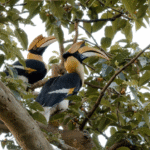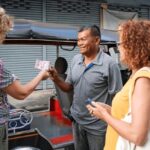CHIANG MAI – In Chiang Mai’s Pa Pong subdistrict, residents have teamed up with private organizations to turn their community forest into a sustainable source of wild mushrooms.
By introducing mushroom spores and using natural farming methods, they can collect and sell mushrooms all year round. The project also brings in EM balls to help restore the forest, turning degraded land into a healthy organic forest again. This method addresses the issue of burning forests to find mushrooms, a practice common in the area. More than 3,000 rai are being used as a model for others across the country.
The people of Thung Yao village planted native trees like Yang Na and other hardwoods, adding 16 types of mushroom-friendly microbes to the roots. The goal is to bring balance back to the land and set up a natural mushroom farm.
Within a year, the spores in the soil are expected to spread, producing a variety of wild mushrooms, including Astraeus, Russula, paddy straw mushrooms, and black earth mushrooms for the community to eat and sell.

Villagers also spread beneficial microbes and EM balls across over 2,300 rai of forest and water sources. This helps break down dry leaves, which fuel fires, and turns them into natural fertilizer.
The project is part of the “Restoring Balance to Community Forests with Microbes” program, run by a network of local conservation groups.
This effort boosts the health of 3,000 rai of watershed forests, including areas like Huai Ton Yang Forest in Village 8, and parts of the Khun Nam Mae Kuang Reserved Forest.
Support comes from several groups, including the Thailand Institute of Scientific and Technological Research, Maejo University, the Mycorrhiza Mushroom Foundation from Phrae, as well as the GULF group and Chiang Mai Waste to Energy.
Locals visited successful mushroom farms in Phrae province to learn new skills and bring the knowledge back to Pa Pong, creating their own wild mushrooms for starter cultures to use in their community forest.
Dr. Sujitra Kosol, chair of the Mycorrhiza Mushroom Foundation, explained that many people don’t realize “mycorrhiza” refers to various local wild mushrooms like Astraeus and Russula. These mushrooms have a close relationship with trees—the fungus gets nutrients from the tree, while the tree receives important minerals, especially phosphate, from the fungus.
Trees growing with mycorrhizal mushrooms can produce flowers and fruit 1.2 to 2 times better than those without.
To add mushroom spores, growers use spores and mycelium from fresh mushrooms. After growing the culture, they mix it with soil or add it to seedlings before planting. Some also shape it into EM balls. This approach succeeded in Phrae’s Nong Suwan village, and the knowledge now supports a learning centre and microbe bank in Pa Pong to share these skills with the community.
Dr. Sujitra also addressed a common belief: burning forests to help mushrooms grow doesn’t work. It kills the spores because fires can reach nearly 1,000 degrees Celsius. Spores near the surface and up to 30cm deep get destroyed.
Rainfall, not fire, is the key—if rain falls above 90mm for a few days, and there’s sunlight, mushrooms will grow, but only if the spores are already there and the forest is healthy.
Sompong Charoensiri, the village head of Pa Pong, said the forest is vital for the people in Doi Saket. In about a year, the introduced mushroom spores should produce a harvest that locals can eat and sell.
They also expect to collect other forest products like Pak Wan (Melientha), ant eggs, and more, all year round, without harming the forest.
Jirasak Meesat, community relations director at GULF CMWTE, noted Chiang Mai has suffered from PM2.5 pollution due to forest burning, which some believe helps mushrooms grow. Now, growing wild mushrooms without burning gives locals a new way to earn income and helps protect the environment.
This sustainable approach not only curbs pollution but also boosts incomes by encouraging seedling production in healthy forests. It sets a model for other regions to follow, showing how conservation and community development can go hand in hand.
















